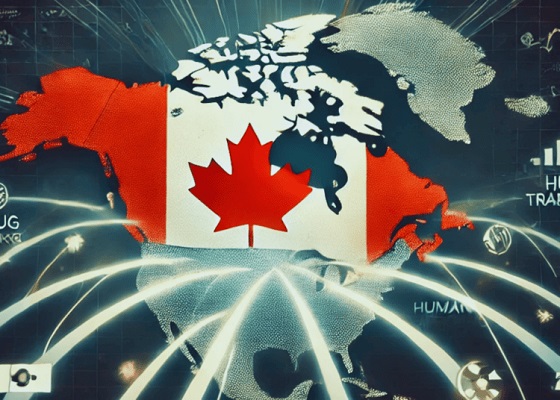Business
Canada’s struggle against transnational crime & money laundering

From the Macdonald-Laurier Institute
By Alex Dalziel and Jamie Ferrill
In this episode of the Macdonald-Laurier Institute’s Inside Policy Talks podcast, Senior Fellow and National Security Project Lead Alex Dalziel explores the underreported issue of trade-based money laundering (TBML) with Dr. Jamie Ferrill, the head of financial crime studies at Charles Sturt University in Canberra, Australia and a former Canada Border Services Agency officer.
The discussion focuses on how organized crime groups use global trade transactions to disguise illicit proceeds and the threat this presents to the Canada’s trade relationship with the US and beyond.
Definition of TBML: Trade-based money laundering disguises criminal proceeds by moving value through trade transactions instead of transferring physical cash. Criminals (usually) exploit international trade by manipulating trade documents, engaging in phantom shipping, and altering invoices to disguise illicit funds as legitimate commerce, bypassing conventional financial scrutiny. As Dr. Ferrill explains, “we have dirty money that’s been generated through things like drug trafficking, human trafficking, arms trafficking, sex trafficking, and that money needs to be cleaned in one way or another. Trade is one of the ways that that’s done.”
A Pervasive Problem: TBML is challenging to detect due to the vast scale and complexity of global trade, making it an attractive channel for organized crime groups. Although global estimates are imprecise, the Financial Action Task Force and The United Nations Office on Drugs and Crime (UNODC) suggests 2-5% of GDP could be tied to money laundering, representing trillions of dollars annually. In Canada, this could mean over $70 billion in potentially laundered funds each year. Despite the scope of TBML, Canada has seen no successful prosecutions for criminal money laundering through trade, highlighting significant gaps in identifying, investigating and prosecuting these complex cases.
Canada’s Vulnerabilities: Along with the sheer volume and complexity of global trade, Canada’s vulnerabilities stem from gaps in anti-money laundering regulation, particularly in high-risk sectors like real estate, luxury goods, and legal services, where criminals exploit weak oversight. Global trade exemplifies the vulnerabilities in oversight, where gaps and limited controls create substantial opportunities for money laundering. A lack of comprehensive export controls also limits Canada’s ability to monitor goods leaving the country effectively. Dr. Ferrill notes that “If we’re seen as this weak link in the process, that’s going to have significant implications on trade partnerships,” underscoring the potential political risks to bilateral trade if Canada fails to address these issues.
International and Private Sector Cooperation: Combating TBML effectively requires strong international cooperation, particularly between Canada and key trade partners like the U.S. The private sector—including freight forwarders, customs brokers, and financial institutions—plays a crucial role in spotting suspicious activities along the supply chain. As Dr. Ferrill emphasizes, “Canada and the U.S. can definitely work together more efficiently and effectively to share and then come up with some better strategies,” pointing to the need for increased collaboration to strengthen oversight and disrupt these transnational crime networks.
Looking to further understand the threat of transnational organized crime to Canada’s borders?
Check out Inside Policy Talks recent podcasts with Christian Leuprecht, Todd Hataley and Alan Bersin.
To learn more about Dr. Ferrill’s research on TBML, check out her chapter in Dirty Money: Financial Crime in Canada.
Business
Some Of The Wackiest Things Featured In Rand Paul’s New Report Alleging $1,639,135,969,608 In Gov’t Waste


From the Daily Caller News Foundation
Republican Kentucky Sen. Rand Paul released the latest edition of his annual “Festivus” report Tuesday detailing over $1 trillion in alleged wasteful spending in the U.S. government throughout 2025.
The newly released report found an estimated $1,639,135,969,608 total in government waste over the past year. Paul, a prominent fiscal hawk who serves as the chairman of the Senate Homeland Security and Governmental Affairs Committee, said in a statement that “no matter how much taxpayer money Washington burns through, politicians can’t help but demand more.”
“Fiscal responsibility may not be the most crowded road, but it’s one I’ve walked year after year — and this holiday season will be no different,” Paul continued. “So, before we get to the Feats of Strength, it’s time for my Airing of (Spending) Grievances.”
Dear Readers:
As a nonprofit, we are dependent on the generosity of our readers.
Please consider making a small donation of any amount here.
Thank you!
The 2025 “Festivus” report highlighted a spate of instances of wasteful spending from the federal government, including the Department of Health and Human Services (HHS) spent $1.5 million on an “innovative multilevel strategy” to reduce drug use in “Latinx” communities through celebrity influencer campaigns, and also dished out $1.9 million on a “hybrid mobile phone family intervention” aiming to reduce childhood obesity among Latino families living in Los Angeles County.
The report also mentions that HHS spent more than $40 million on influencers to promote getting vaccinated against COVID-19 for racial and ethnic minority groups.
The State Department doled out $244,252 to Stand for Peace in Islamabad to produce a television cartoon series that teaches children in Pakistan how to combat climate change and also spent $1.5 million to promote American films, television shows and video games abroad, according to the report.
The Department of Veterans Affairs (VA) spent more than $1,079,360 teaching teenage ferrets to binge drink alcohol this year, according to Paul’s report.
The report found that the National Science Foundation (NSF) shelled out $497,200 on a “Video Game Challenge” for kids. The NSF and other federal agencies also paid $14,643,280 to make monkeys play a video game in the style of the “Price Is Right,” the report states.
Paul’s 2024 “Festivus” report similarly featured several instances of wasteful federal government spending, such as a Las Vegas pickleball complex and a cabaret show on ice.
The Trump administration has been attempting to uproot wasteful government spending and reduce the federal workforce this year. The administration’s cuts have shrunk the federal workforce to the smallest level in more than a decade, according to recent economic data.
Festivus is a humorous holiday observed annually on Dec. 23, dating back to a popular 1997 episode of the sitcom “Seinfeld.” Observance of the holiday notably includes an “airing of grievances,” per the “Seinfeld” episode of its origin.
Alberta
A Christmas wish list for health-care reform

From the Fraser Institute
By Nadeem Esmail and Mackenzie Moir
It’s an exciting time in Canadian health-care policy. But even the slew of new reforms in Alberta only go part of the way to using all the policy tools employed by high performing universal health-care systems.
For 2026, for the sake of Canadian patients, let’s hope Alberta stays the path on changes to how hospitals are paid and allowing some private purchases of health care, and that other provinces start to catch up.
While Alberta’s new reforms were welcome news this year, it’s clear Canada’s health-care system continued to struggle. Canadians were reminded by our annual comparison of health care systems that they pay for one of the developed world’s most expensive universal health-care systems, yet have some of the fewest physicians and hospital beds, while waiting in some of the longest queues.
And speaking of queues, wait times across Canada for non-emergency care reached the second-highest level ever measured at 28.6 weeks from general practitioner referral to actual treatment. That’s more than triple the wait of the early 1990s despite decades of government promises and spending commitments. Other work found that at least 23,746 patients died while waiting for care, and nearly 1.3 million Canadians left our overcrowded emergency rooms without being treated.
At least one province has shown a genuine willingness to do something about these problems.
The Smith government in Alberta announced early in the year that it would move towards paying hospitals per-patient treated as opposed to a fixed annual budget, a policy approach that Quebec has been working on for years. Albertans will also soon be able purchase, at least in a limited way, some diagnostic and surgical services for themselves, which is again already possible in Quebec. Alberta has also gone a step further by allowing physicians to work in both public and private settings.
While controversial in Canada, these approaches simply mirror what is being done in all of the developed world’s top-performing universal health-care systems. Australia, the Netherlands, Germany and Switzerland all pay their hospitals per patient treated, and allow patients the opportunity to purchase care privately if they wish. They all also have better and faster universally accessible health care than Canada’s provinces provide, while spending a little more (Switzerland) or less (Australia, Germany, the Netherlands) than we do.
While these reforms are clearly a step in the right direction, there’s more to be done.
Even if we include Alberta’s reforms, these countries still do some very important things differently.
Critically, all of these countries expect patients to pay a small amount for their universally accessible services. The reasoning is straightforward: we all spend our own money more carefully than we spend someone else’s, and patients will make more informed decisions about when and where it’s best to access the health-care system when they have to pay a little out of pocket.
The evidence around this policy is clear—with appropriate safeguards to protect the very ill and exemptions for lower-income and other vulnerable populations, the demand for outpatient healthcare services falls, reducing delays and freeing up resources for others.
Charging patients even small amounts for care would of course violate the Canada Health Act, but it would also emulate the approach of 100 per cent of the developed world’s top-performing health-care systems. In this case, violating outdated federal policy means better universal health care for Canadians.
These top-performing countries also see the private sector and innovative entrepreneurs as partners in delivering universal health care. A relationship that is far different from the limited individual contracts some provinces have with private clinics and surgical centres to provide care in Canada. In these other countries, even full-service hospitals are operated by private providers. Importantly, partnering with innovative private providers, even hospitals, to deliver universal health care does not violate the Canada Health Act.
So, while Alberta has made strides this past year moving towards the well-established higher performance policy approach followed elsewhere, the Smith government remains at least a couple steps short of truly adopting a more Australian or European approach for health care. And other provinces have yet to even get to where Alberta will soon be.
Let’s hope in 2026 that Alberta keeps moving towards a truly world class universal health-care experience for patients, and that the other provinces catch up.
-

 Agriculture1 day ago
Agriculture1 day agoWhy is Canada paying for dairy ‘losses’ during a boom?
-

 Automotive2 days ago
Automotive2 days agoFord’s EV Fiasco Fallout Hits Hard
-

 Alberta1 day ago
Alberta1 day agoAlberta’s new diagnostic policy appears to meet standard for Canada Health Act compliance
-

 Alberta15 hours ago
Alberta15 hours agoHousing in Calgary and Edmonton remains expensive but more affordable than other cities
-

 Business14 hours ago
Business14 hours agoState of the Canadian Economy: Number of publicly listed companies in Canada down 32.7% since 2010
-

 Censorship Industrial Complex12 hours ago
Censorship Industrial Complex12 hours agoCanadian university censors free speech advocate who spoke out against Indigenous ‘mass grave’ hoax
-

 Bruce Dowbiggin16 hours ago
Bruce Dowbiggin16 hours agoHunting Poilievre Covers For Upcoming Demographic Collapse After Boomers
-

 Censorship Industrial Complex1 day ago
Censorship Industrial Complex1 day agoTop constitutional lawyer warns against Liberal bills that could turn Canada into ‘police state’






